I do agree that it's been a bit quiet lately... I think at least somewhat the current global health and finance situation is having a bit of an effect of late...
Quick and Dirty 2: A Soviet Resurgence and WW3 (HOI3 - March 1944 start)
- Thread starter Bullfilter
- Start date
-
We have updated our Community Code of Conduct. Please read through the new rules for the forum that are an integral part of Paradox Interactive’s User Agreement.
You are using an out of date browser. It may not display this or other websites correctly.
You should upgrade or use an alternative browser.
You should upgrade or use an alternative browser.
Threadmarks
View all 71 threadmarks
Reader mode
Reader mode
Recent threadmarks
Chapter 58: 11 to 20 November 1948 Chapter 59: 21 to 30 November 1948 Chapter 60: December 1948 Chapter 61: 1 to 16 January 1949 Chapter 62: 17 to 31 January 1949 Chapter 63: 1 to 14 February 1949 Chapter 64: 15 to 27 February 1949 The Diplomatic Revolution Mod for HOI3 - An AdvertisementIn fact I was expecting an uptick in the forums as a result of people staying home instead of catching the virus outside, but it's been the opposite. So I started a game as the count of Monenvasia, who has the single Hellenic religion person in its court. The aim is to stay alive in the Byzantium Empire while growing the realm somewhat if possible and breed some Hellenic courtiers to somehow embrace it as a secret religion in the future. I wish I had your productivity as an authAAR as well, it could've been a nice story. Still with the first ruler, recently received a temporary duchy (strategos) title from the empire. Going well so far.Is it just me, or have the forums been a little quiet in recent days? Maybe a seasonal thing. In any case, here's some more feedback as the next chapter of this AAR nears completion. Apologies for the gap between updates, but when there's a four-AAR update cycle, things can stretch out a little, what with RL 'n' all!
I suspect that a large portion of forum activity is bored folks in the office. Take the bored folk out of the office, and...In fact I was expecting an uptick in the forums as a result of people staying home instead of catching the virus outside, but it's been the opposite.
Yes, but maybe people will get bored and start watching/updating again?I do agree that it's been a bit quiet lately... I think at least somewhat the current global health and finance situation is having a bit of an effect of late...
Same here. Maybe that might happen later. Good luck with that game!In fact I was expecting an uptick in the forums as a result of people staying home instead of catching the virus outside, but it's been the opposite. So I started a game as the count of Monenvasia, who has the single Hellenic religion person in its court. The aim is to stay alive in the Byzantium Empire while growing the realm somewhat if possible and breed some Hellenic courtiers to somehow embrace it as a secret religion in the future. I wish I had your productivity as an authAAR as well, it could've been a nice story. Still with the first ruler, recently received a temporary duchy (strategos) title from the empire. Going well so far.
Ah, a good point, hadn't thought of that! But maybe they will get bored again and return once the self-isolation regime begins to pale ...I suspect that a large portion of forum activity is bored folks in the office. Take the bored folk out of the office, and...
Chapter 10 – December 1944
Chapter 10 – December 1944
AuthAAR’s Notes: With a lot happening in December - in places anyway - I am striving to keep the AAR quick and dirty. I must resist the compulsion to report too much detail! Broad sweep, I keep telling myself. But there was this epic battle, and …
Command Adjustments
Before operations kicked off in December, the Soviets adjusted their command structure in the Far East Theatre. 2nd FE Front was brought out of reserve status and assumed command of 1st and 7th Armies in the Southern sector. 1st FE Front retained command of 6th and 15th Armies in the north. The Transcaucasus Front, also pre-positioned in the east, was redesignated as the 3rd FE Front (Reserve) and took command of the two remaining reserve corps HQs. The 2nd FE Front commander, Marshal V.I. Chistyakov, set a mildly aggressive tactical focus for his 206,000 troops.
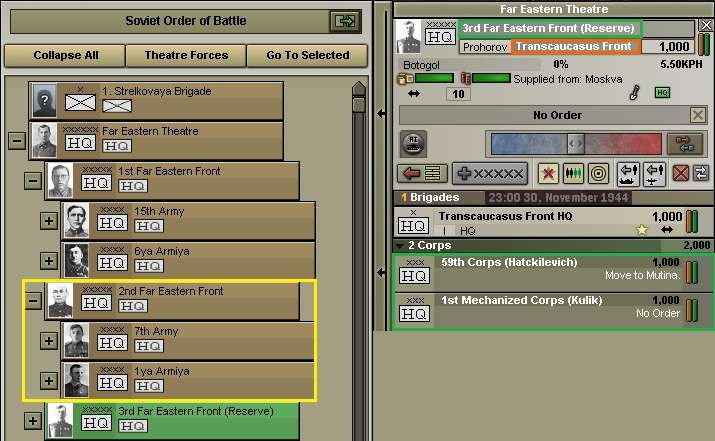
1st Army’s objectives remained unchanged. Though in the change of command, their land and air stances reverted to defensive and this wasn’t recognised by the new Front commander for some days. [ ]
]
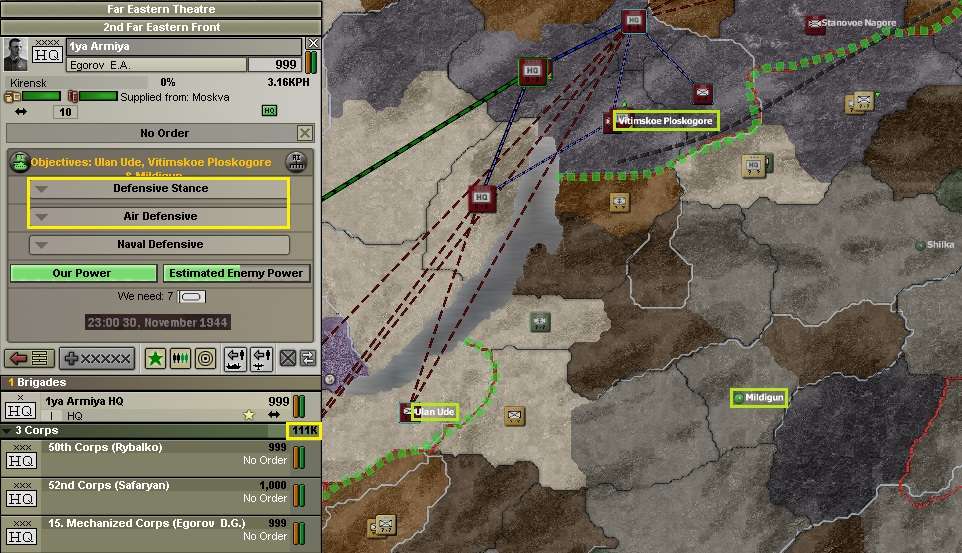
7th Army retained its objectives too (and also reverted to a defensive stance  ).
).
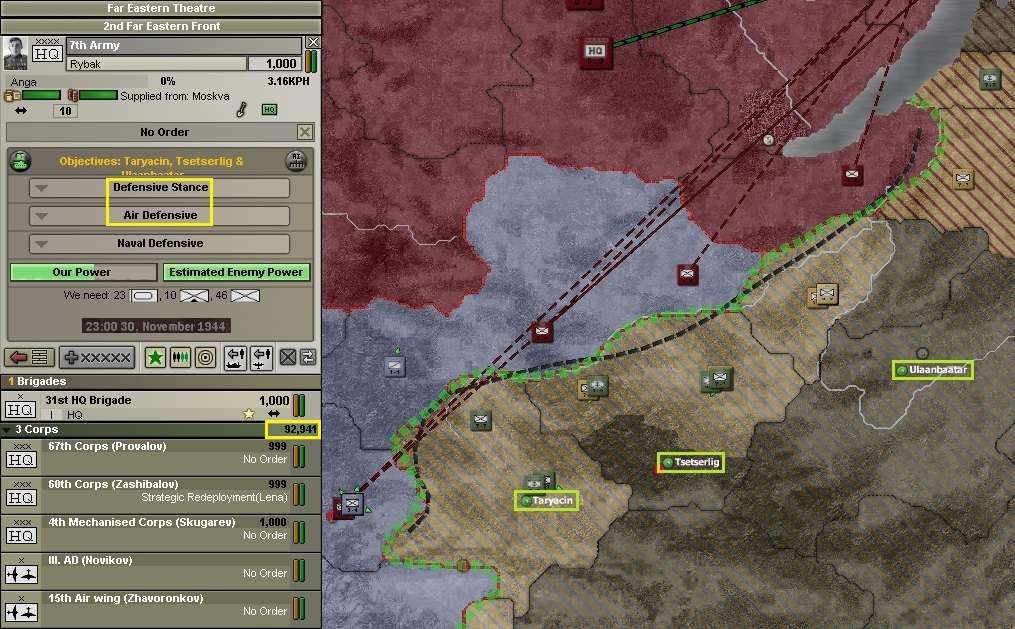
The stances and objectives of 6th Army (land defence, air offence) and 15th Army (land attacking, air offensive) remained unaffected.
1. Far East Land Combat – Northern and Central Sectors
Combat north of Lake Baikal for December was focused entirely in the Central Sector in and around Novaya Chara, which saw an unprecedented succession of combats over the entire month. The battle there started at 0100 hr on 1 December, with an attack by three Japanese divisions (infantry, guards and marines) on the Soviet 21 Tank Div and 11 SD.
By 0500 on 2 December, the Soviet commander MAJGEN P.A. Mironov had broken up the enemy attack with a counter-attack. The Soviets had the advantage of terrain, a river defence, entrenchment and weather, but were outnumbered about two-to-one.
The Soviets also had air support, with aircraft based in Mutina heavily involved in spoiling attacks on various provinces the enemy were attacking from throughout the month. Their initial focus was on Kedrovvy, then Mogoca, later Erofej Pavlovic. The Japanese launched two air raids (1 x TAC, 1 x MR wing) on Novaya Chara on 2 December, but were intercepted (3 x INT) in two dogfights that day. The Soviets fighter group then aggressively patrolled above the enemy’s air base in Tyndinskiy the next day. The Japanese flyers did not reappear in this sector for the rest of the month.
By 1300 hr on 9 December, the marathon battle in Novaya Chara continued unabated: 11 SD was reaching breaking point, but 21 Tank Div remained strong. The Japanese were also taking heavy casualties [notional progress remained at around 34% in favour of the Soviets, as it had since the start of the battle]. This changed at 2200 hr on 10 December, when 53 Hoheoishidan joined the Japanese attack in reserved [5.9% reinforcement chance, attack progress to 44%].
At 1200 hr on 10 December, 11 SD could take no more: they broke and headed to Sinyuga, leaving Mironov and his 21 Tank Div to withstand the enemy assault from three directions alone.
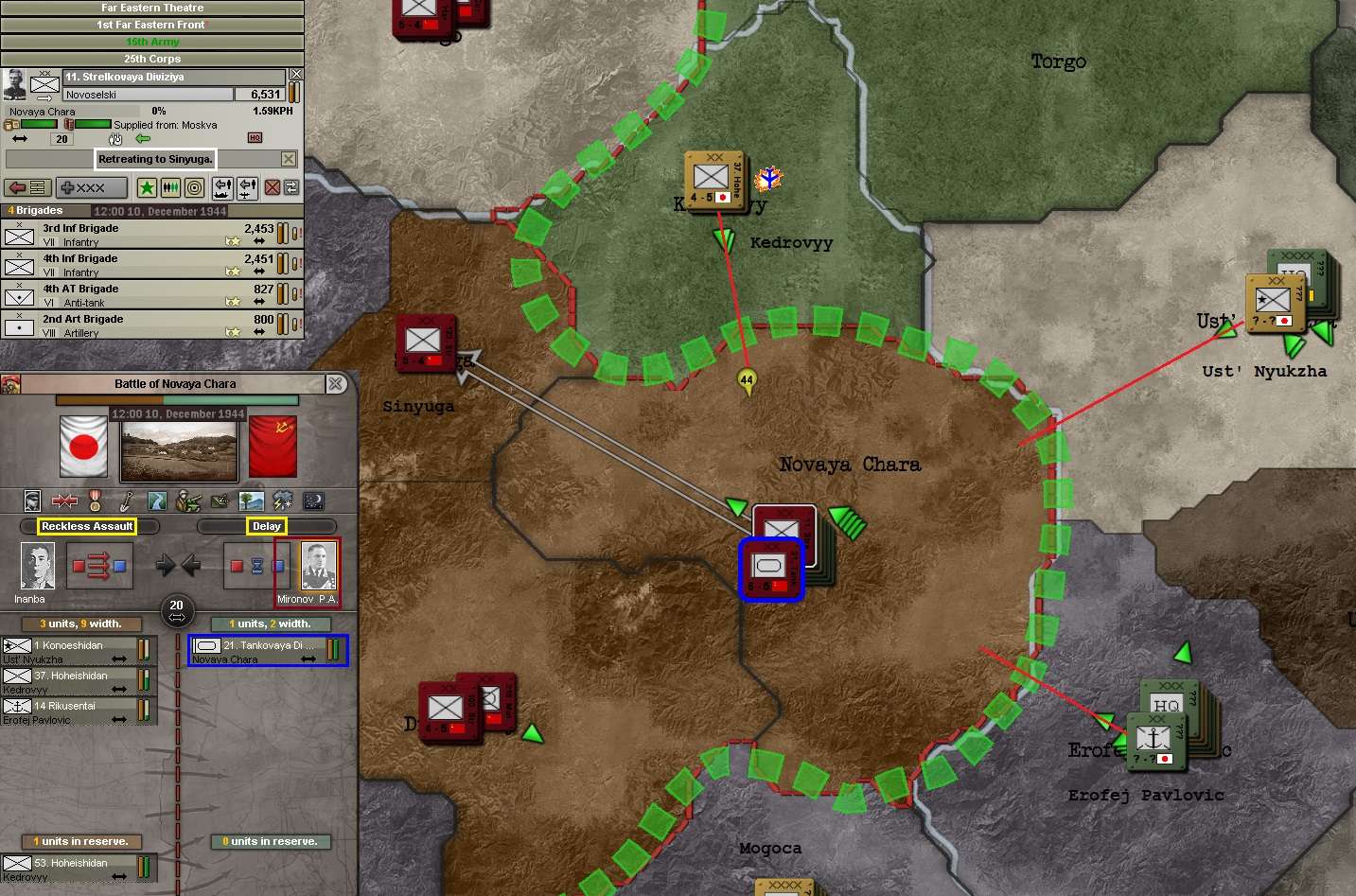
Things got tougher again for Mironov when 53 Hoheishidan reinforced at 2200 on 10 December. Two days later, the Soviets still resisted strongly, counter-attacking the shock assault the Japanese had launched. 1 Koneishidan (Guards) Div – which had been leading the attack - had by then been heavily damaged and was badly disorganised. But they were still there at 1600 hr that afternoon, when a fifth enemy division joined the fight in reserve [progress to 64%].
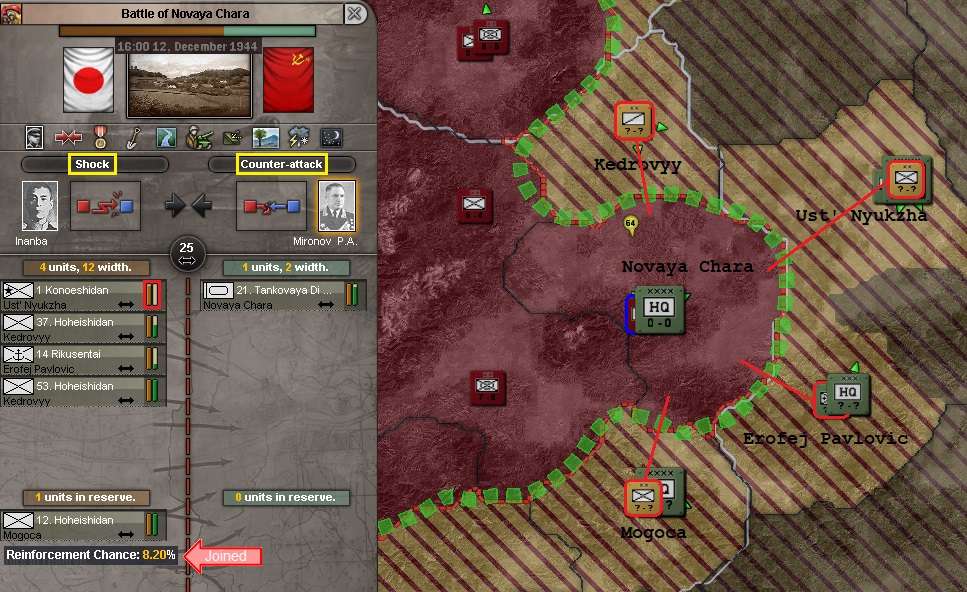
Eight hours later, the Japanese had reverted to a simple attack, which Mironov met with an elastic defence. And a query as to when he might expect some reinforcement for his desperate defence, given none had yet been ordered and travel was slow in the Far Eastern wilderness. HQ 15th Army considered the request. Mironov’s odds improved a little [60%] when the Japanese 1st Guards withdrew at 1500 hr on 13 December, leaving them with two worn and two fresh divisions against the single Soviet tank division.
One reason the Soviet tank division had been able to withstand more than two weeks of Japanese attacks with relatively little organisational damage, when 11 SD had failed, was that the armour of the T-34s of 21 Tank Div [Armour 9] was better than the piercing attack of all the Japanese divisions [maximum of 7]. This heavily reduced the damage they took [ie by 50%].
Finally, at 2100 hr on 15 December, Mironov was advised that two Soviet tank divisions – the 15th (light) from Sinyuga and the 8th (medium) from Dronovskiy – had been ordered to relieve him. But it would take them around ten days to get to Novaya Chara, meaning Mironov and his men had a grim time ahead. At least they had regular (if not continuous) air support on the attacking formations throughout their wait for relief.
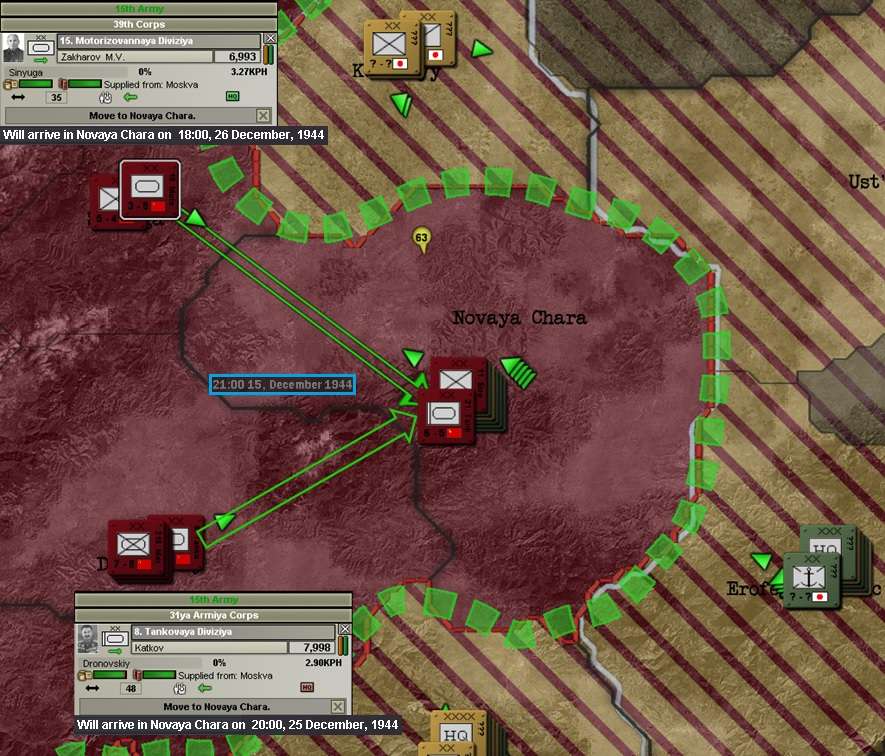
Another factor in the Soviet’s tenacious defence was the consistently better tactics Mironov chose over this time, which often decreased the enemy’s damage and rate of attack [attack vs tactical withdrawal on 17 December, attack vs elastic defence on 18 December, for example]. At 0400 hr on 19 December another Japanese division withdrew, leaving three, but they launched an assault, which Mironov could only meet with a simple defence. And his men were finally beginning to tire.
But Mironov hung in, and by 0000hr on 21 December, the enemy assault was neutralised with a brave counter-attack and the Japanese marines were now close to breaking. However, the odds had risen [to 77%] in favour of the attackers. Then, at 0600 hr that morning, the news came that the battle was over. The marines had withdrawn and the Japanese broke off their attack! Casualties had been ferocious for both sides, but the Japanese had lost over 3,600 men. Mironov was immediately made a Hero of the Soviet Union for his amazing defensive effort – over twenty days of resistance, much of it with just his own division.
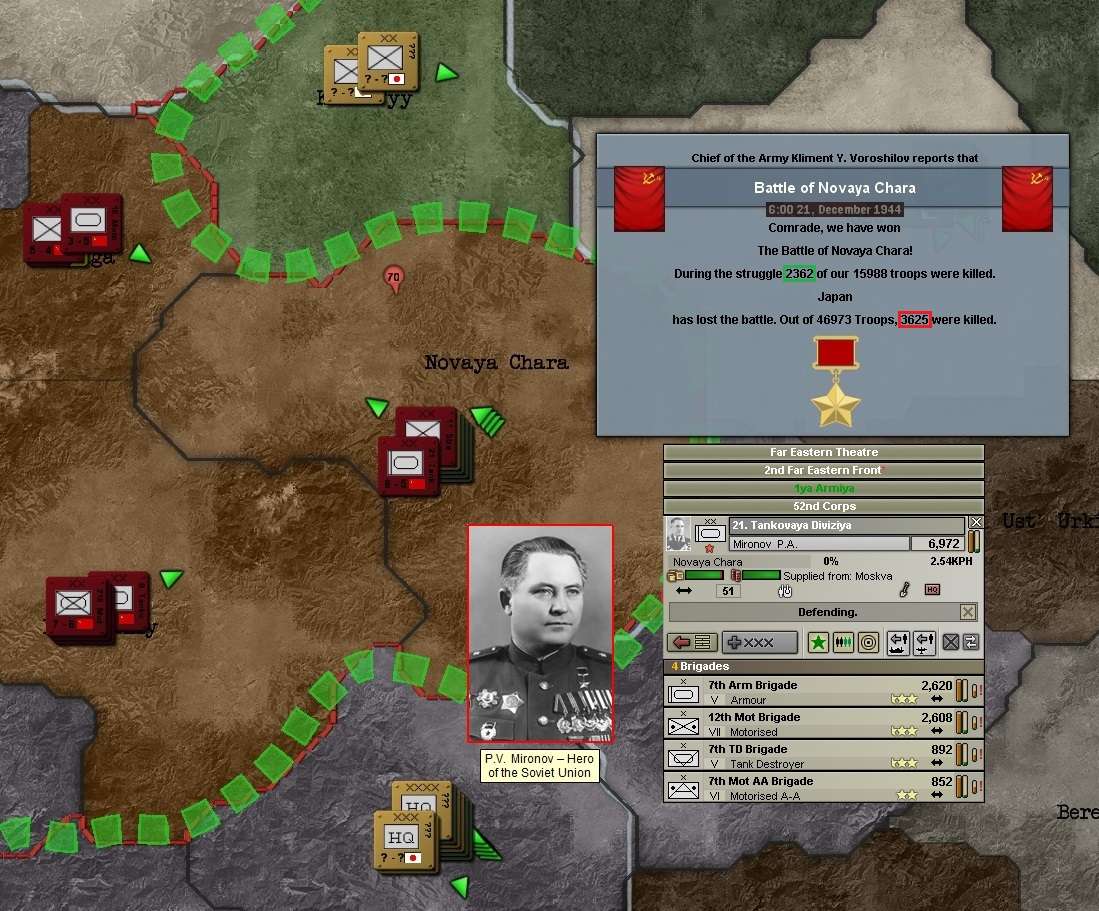
Mironov only had four hours to celebrate, however. A new attack [40% starting progress] was launched at 1000 hr that morning, by another Japanese guards division! His exhausted men still had another four days to hold out before relief would arrive. Two hours later, the 12th Hoheishidan joined the reserve and then reinforced at 1400 hr [progress to 77%]. How long could the 21st Tanks, heroes all, hold on?

By 1000 hr on 22 December, the Japanese yelled ‘Banzai’ and launched a reckless assault, to which the Soviets reacted with an elastic defence: the battle had reached a crescendo! [The net tactical effect of these two was attacker damage +35% but speed -25%, vs defender damage +35%.]
At 2200 hr on 22 December, as the battle raged on in Novaya Chara, the forces in Sinyuga were diverted from their relief march and instead began an attack on Kedrovvy, to the north of Novaya Chara (neither of the two enemy units there were attacking Novaya Chara at the time). But 8 Tank Div was still advancing from the south-west and was due to arrive on the evening of Christmas Day.
By 1300 hr on 23 December 21 Tank Div held on grimly and Mironov delivery a ‘backhand blow’ [attacker damage -25%, defender damage +25%, attacker speed -30%] to the enemy attack: but the Japanese had brought up yet another fresh division into reserve [attack progress now at 91%]. 20th Hoheishidan reinforced nine hours later. Then at 1500 hr 24 December, Mironov’s masterful delaying tactics were neutralised by a simple enemy assault – his luck and the organisation of his men [now just 3.5] was running out at last.
It proved the decisive blow: able to take no more, 21 Tank Div broke at 0500 hr on Christmas Day 1944, after 24 days of resistance against overwhelming odds. He was awarded an Order of Lenin to complement his recent Hero of the Soviet Union award. [There was no battle report for this one, unfortunately.] 8 Tank Div was due fifteen hours later – so long as the Japanese did not arrive first, Mironov’s withdrawal was actually well timed, allowing the new formation to fight its own battle when it arrived.
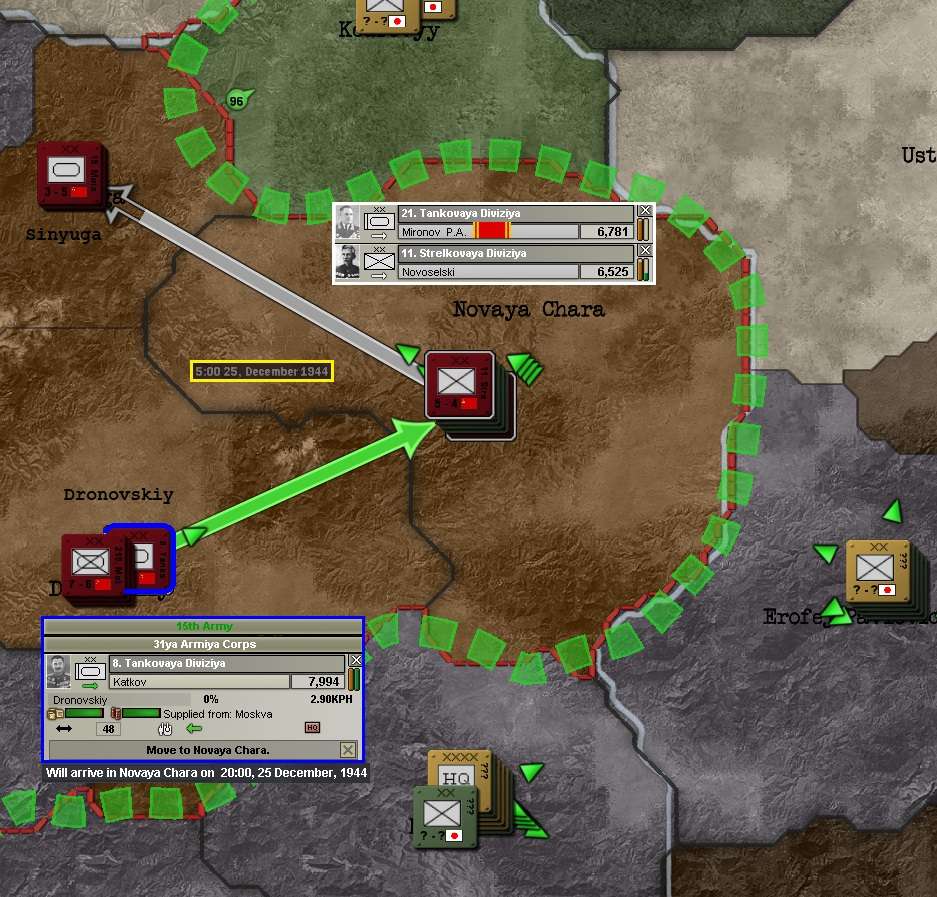
The Soviet attack on Kedrovyy ended in victory just an hour later, after which 8 Tank Div arrived in Novaya Chara as scheduled at 2000 hr. And was immediately attacked by the still advancing Japanese.
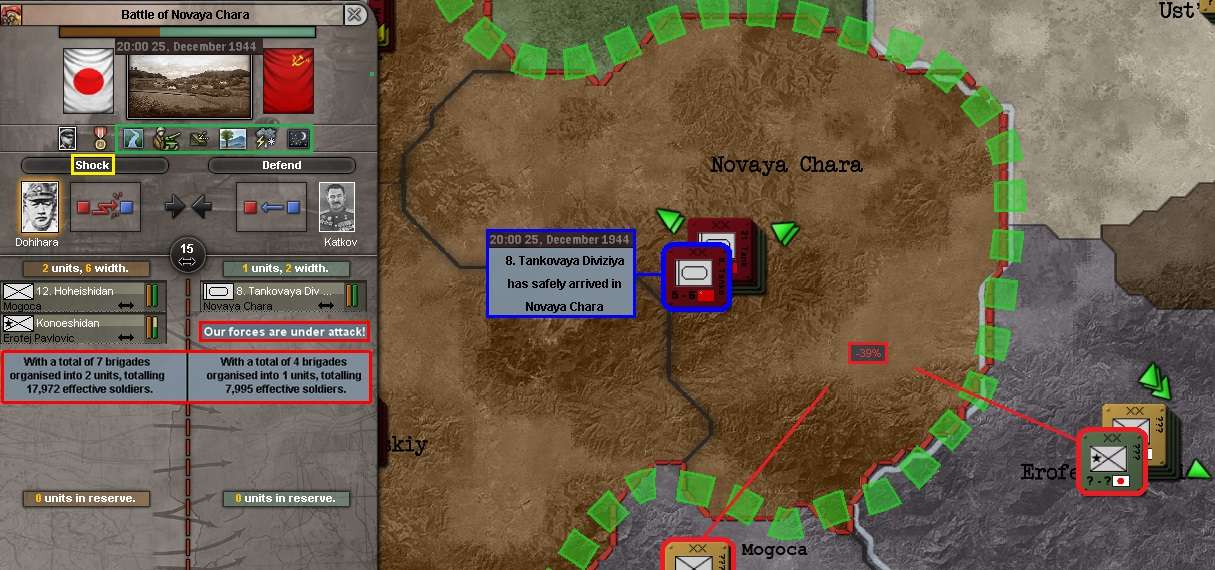
The Japanese guards division broke off two hours later, making the new defenders’ jobs a lot easier, but the Japanese attack persisted.
Meanwhile, on 27 December, the 6th Army was ordered onto an land attacking stance to see if it could make any progress to the north. And on 30 December, the third battle of the month for Novaya Chara ended in Soviet victory, but again no detailed battle report was available. The province had been under attack for 30 consecutive days but, miraculously, was still firmly in Soviet hands as the year ended.
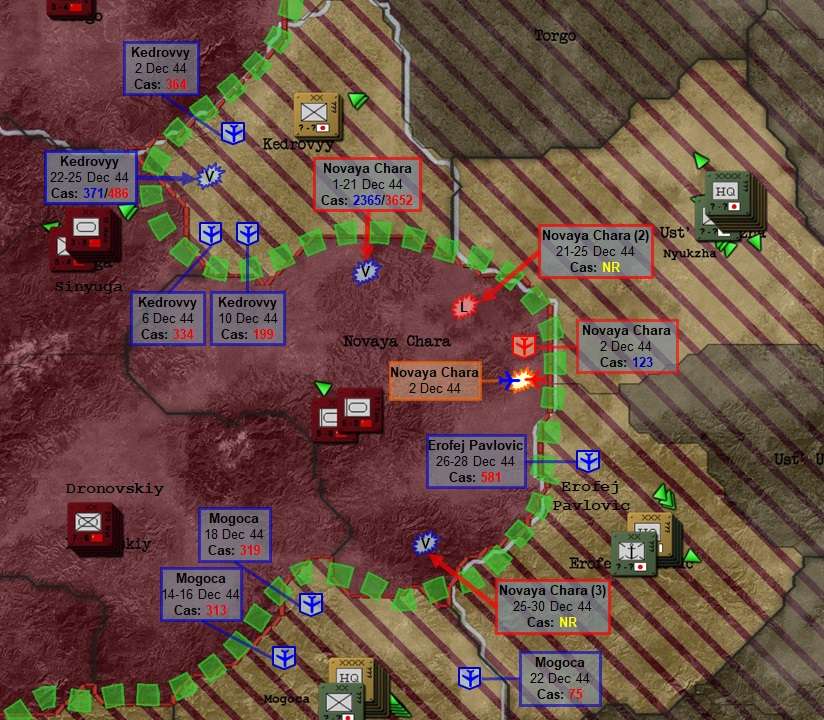
Operational summary, Soviet Far East – Central Sector, December 1944.
2. Far East Land Combat - Southern Sector
The new command arrangements seemed to energise the Southern sector commanders, who soon warmed to their task, in combination with their Mongolian allies. An attack on Ider began at 1000 hr on 1 December, ending in victory early on 4 December, with heavy air support (killing three times as many enemy soldiers from the air than in the land combat). Ider was re-occupied by 81 Mot Div at 1800 hr on 6 December.
Early on 8 December, as a Comintern ground attack on Taryacin was being organised, a Japanese fighter wing made an unwise sortie to intercept inbound Soviet air strikes from Irkutsk. The Japanese themselves were ambushed by Soviet interceptors and were very roughly handled.
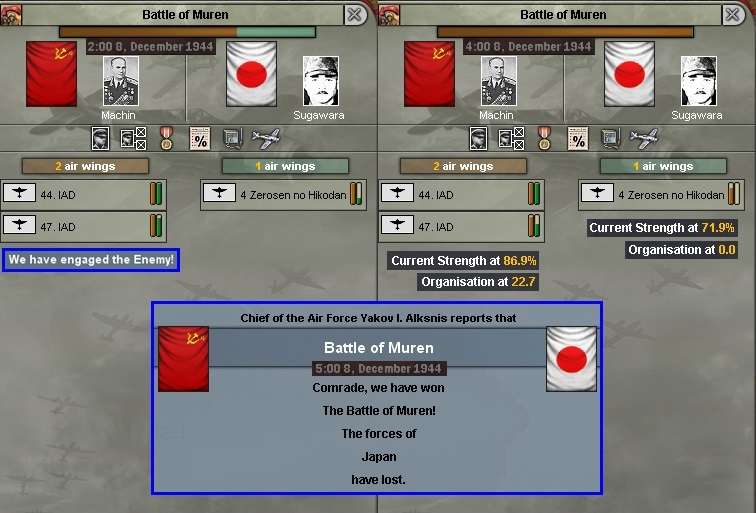
The Mongolians led the attack on Taryacin, with the Soviet 81 Tank (light) Div joining in reserve at 0600 hr on 8 December. It never made much headway, defeat being acknowledged two days later.
Meanwhile, the new 2nd FE Front commander realised he needed to re-send orders for both 1st and 7th Armies to adopt an attacking stance. 1st Army had shown no enthusiasm to do anything with its substantial forces gathered to the north of Lake Baikal. Maybe this would get them moving. It was complemented two days later with a direction for 1st Army’s air units to also go back on the offensive.
But still, nothing happened: Egorov seemed to have lost the will to attack! By 13 December, the need for a diversion to assist the beleaguered 21 Tank Div in Novaya Chara was more urgent than ever. 1st Army was thus ordered to adopt a blitzing stance, in the hope they would drive towards their depth objective of Mildigun.
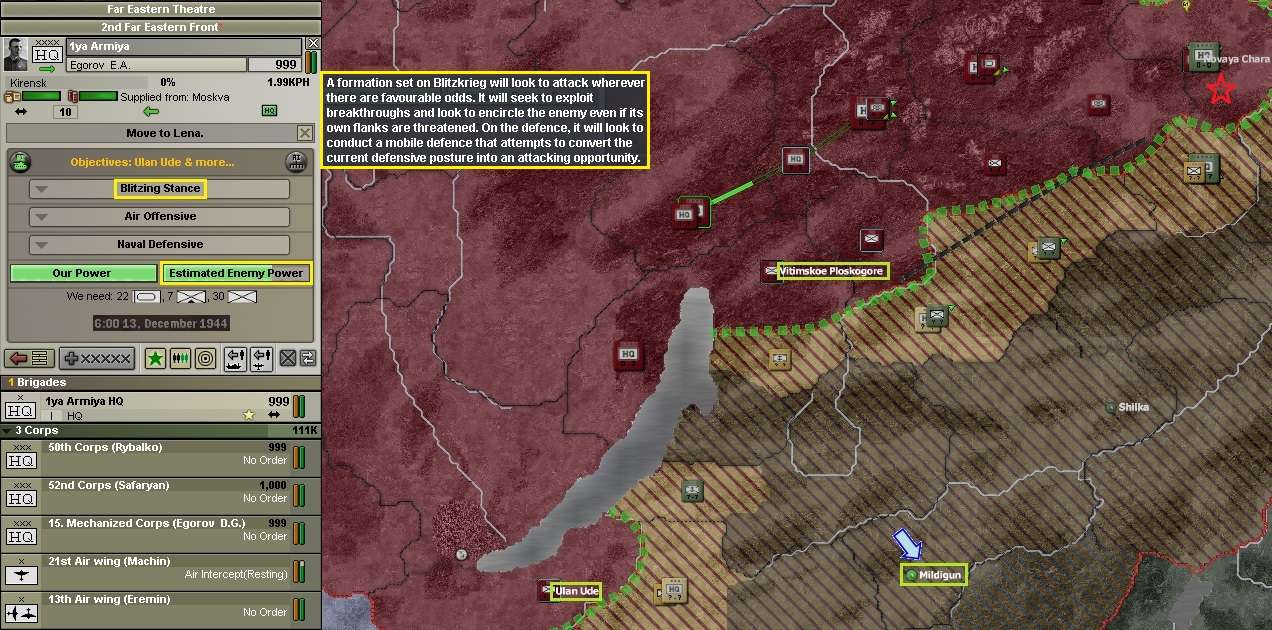
7th Army needed no such prodding, launching a new Soviet-led (81 Tank Div, from Ider) attack on Taryacin, again with heavy air support, at 1300 hr on 14 December. But while that attack progressed fairly well, by the afternoon of 15 December 1st Army had still not moved forward. Next, the defensive objective of Vitimskoe Ploskogore (north of Lake Baikal) was removed, in case that was holding Egorov back. With no action forthcoming, two days later the other defensive objective of Alan Ude (to the south of Lake Baikal) was also removed, replaced with another attacking objective: Shilka, shared with 15th Army.
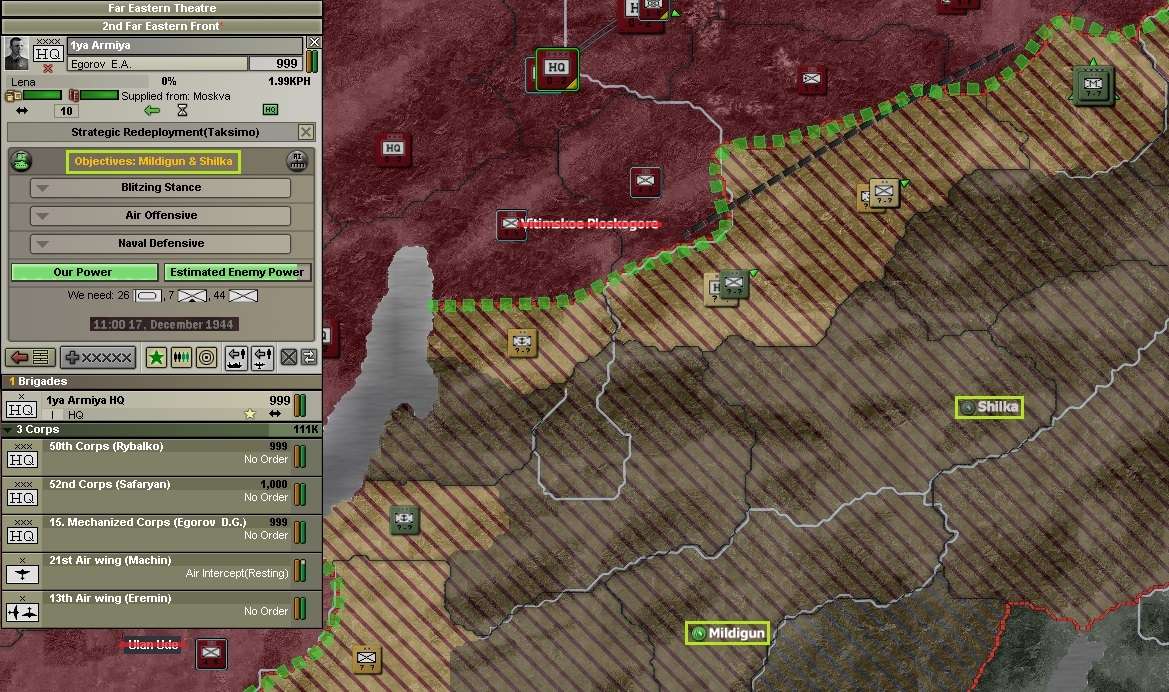
The battle for Taryacin was won at 1300 hr on 19 December. By 0400 hr on 21 December, 81 Tank Div had re-occupied the province – but was immediately attacked from Tsetserlig by 26 Hoheishidan. Heavy Soviet air raids began on Tsetserlig the next day – and would continue all the way through to the end of the month, twice per day, eventually causing enormous casualties to the units grouped there, not all of whom were attacking Taryacin.
By now imbued with the spirit of aggression, 7th Army next launched an attack on Dzhirgalanta with 79 SD from Ider, against two weakened Japanese divisions (marines and infantry), at 0500 hr on 21 December. They too received substantial air support from Irkutsk, even while the air strikes continued simultaneously on Tsetserlig. Victory in Dzhirgalanta came on 24 December, but there was no report of casualties available.
26 December rolled around with still no offensive action from 1st Army, which had 11 divisions massed opposite Burjatija and Bukacaca. In a further attempt to promote an attack, those two provinces were made specific objectives, with Mildigun as the depth objective. Marshal Egorov came back with a lame demand for a further 27 medium tank brigades, ten mountain brigades and 45 infantry brigades, even though his own analysts estimated he already outmatched the enemy on his front by a small margin – and heavily (about five-to-one) in the designated attack sector. Soviet authorities were at a loss as to what more they could do to get an attack happening. [And I’m resisting the temptation to step in and take direct command to set up an attack. For now .]
.]
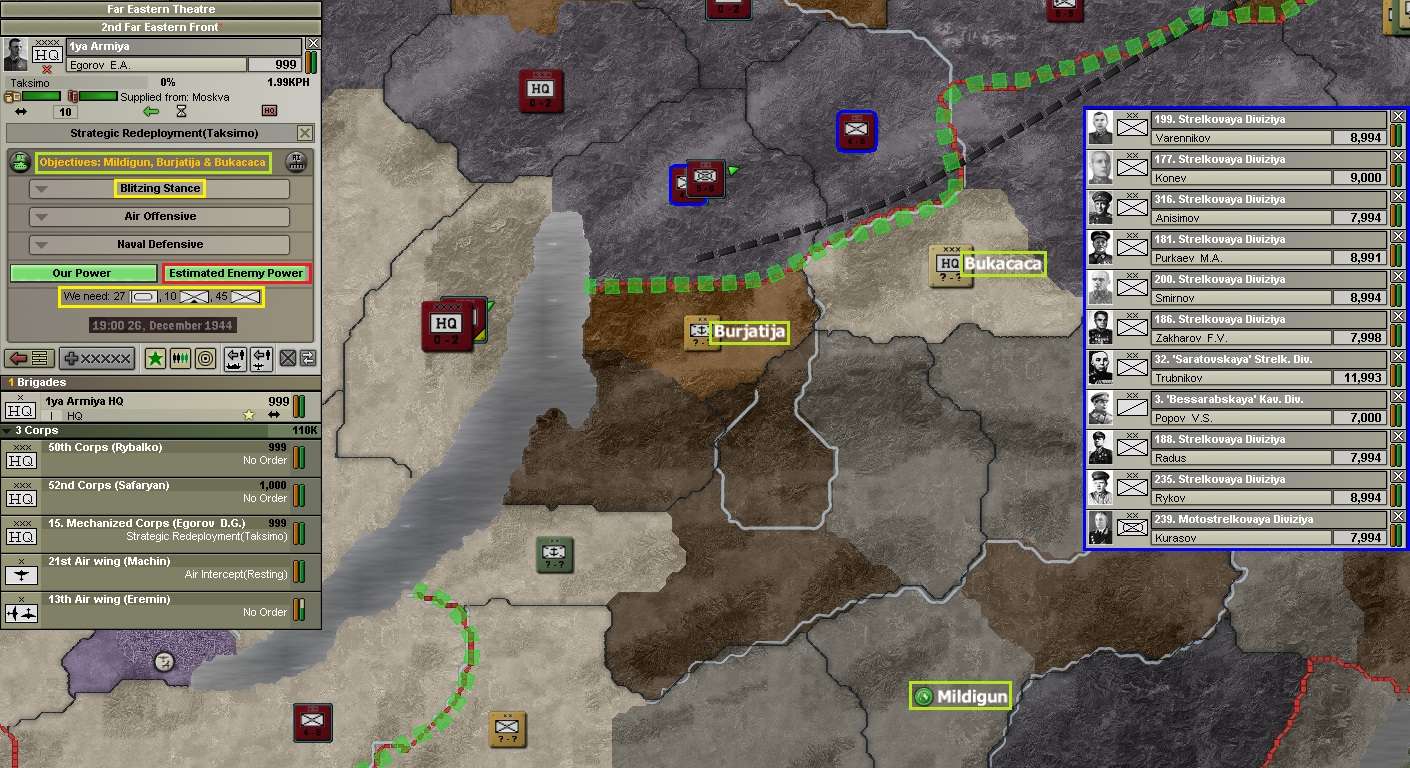
On 27 December the Japanese fighter wing again tried to interfere with Soviet ground attack missions, but were intercepted by Soviet fighters over Slyudyanka (just south of Irkutsk) and again heavily damaged – they did not return again that month.
The attack on Taryacin continued, rather like a smaller parallel of the epic battle in Novaya Chara, with two Japanese infantry divisions and 81 Tank Div both suffering organisational degradation and unrelenting Soviet air attacks on Tsetserlig. By 1100 hr on 30 December one of the Japanese divisions withdrew from the attack and a hard-fought Soviet victory coming at 1500 hr on 31 December. The Japanese had lost over 1,200 men in the ground combat and a massive 6,100-plus in air attacks on Tsetserlig.
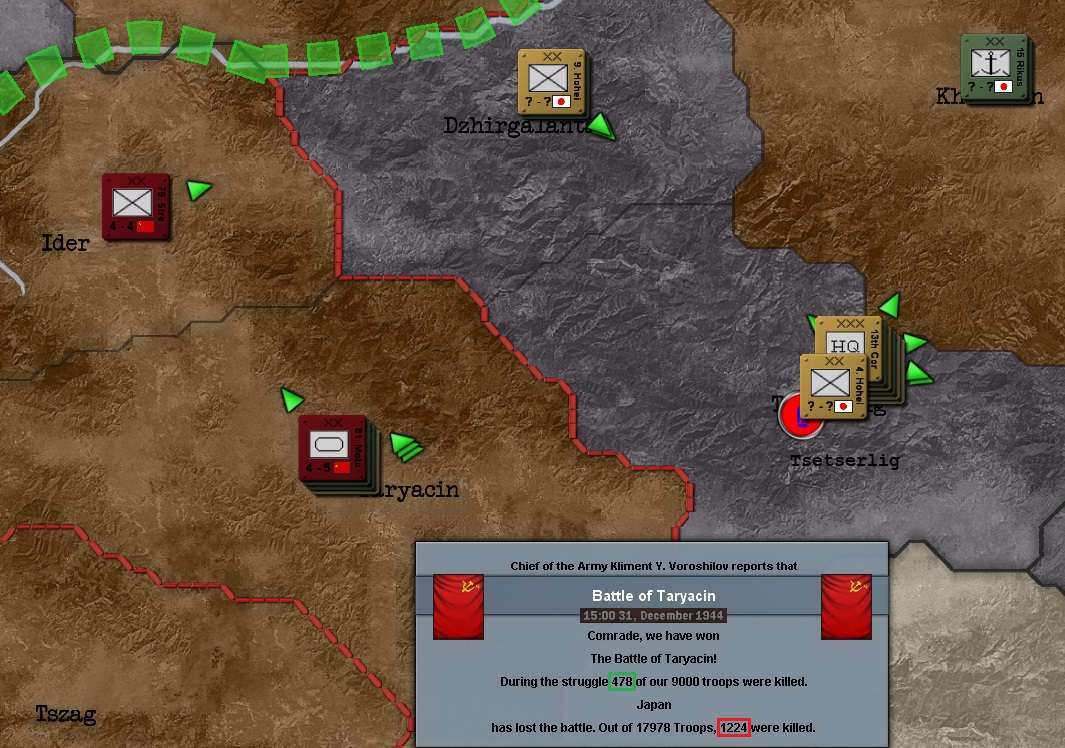

Operational summary, Soviet Far East – Southern Sector, December 1944.
3. Persia
The Persian Front was highly active in December. The main feature was a drive on Tehran from the west and the east, which eventually led to the cutting off of Persian forces trapped in a large pocket to its north. There was also significant fighting in the east of the country. But especially earlier in the month, the Persians won a number of battles, including attacks on advancing Soviet forces.
By the end of December, the Soviets had the upper hand, keeping the ‘Caspian Sea Pocket’ closed and beating off Persian attempts to retake Tehran, with a separate drive commenced towards the oilfields at the top of the Persian Gulf and a Persian counter-offensive into Borun in the east thrown back.
Of note, a check of Western Front objectives at midnight on 31 November showed they had somehow been erased again from the orders to the subordinate armies, so they were all reinstated (all Persian VP cities).
An initial attack on Tehran began on 1 December but was beaten back by the Persians on 6 December, with heavy Soviet losses. Soon after that, a bold Persian attack on the garrison division holding Borun was launched and would prove successful by 0600 hr on 8 December, after which the Persians in Tehran attacked west against Abhar, defeating 183 SD which had been weakened in its earlier attack on the Persian capital and retreated a day later.
With these initial reverses and a scarcity of armoured units in the theatre, the 6th Cav Corps (currently based near Odessa), consisting of two tank divisions, was transferred to the Western Front’s 23rd Army at 1900 hr on 10 December. Abhar was rescued from enemy seizure when 1 Tank (light) Div reached there at 0900 hr on 14 December, halting the enemy advance after a very quick skirmish. They began their own attack on Tehran four hours later. That would end in a tough victory after a seven day battle, the Persian capital being occupied at 2100 hr on 21 December. This also closed off the ‘Caspian Sea Pocket’ to the north, as 1 Tank Div linked up with Soviet forces that had struck from the east. At this point, the Soviets decided they would if possible puppet Persia after a Communist government had been installed. The Persians moved their capital south to Esfahan.
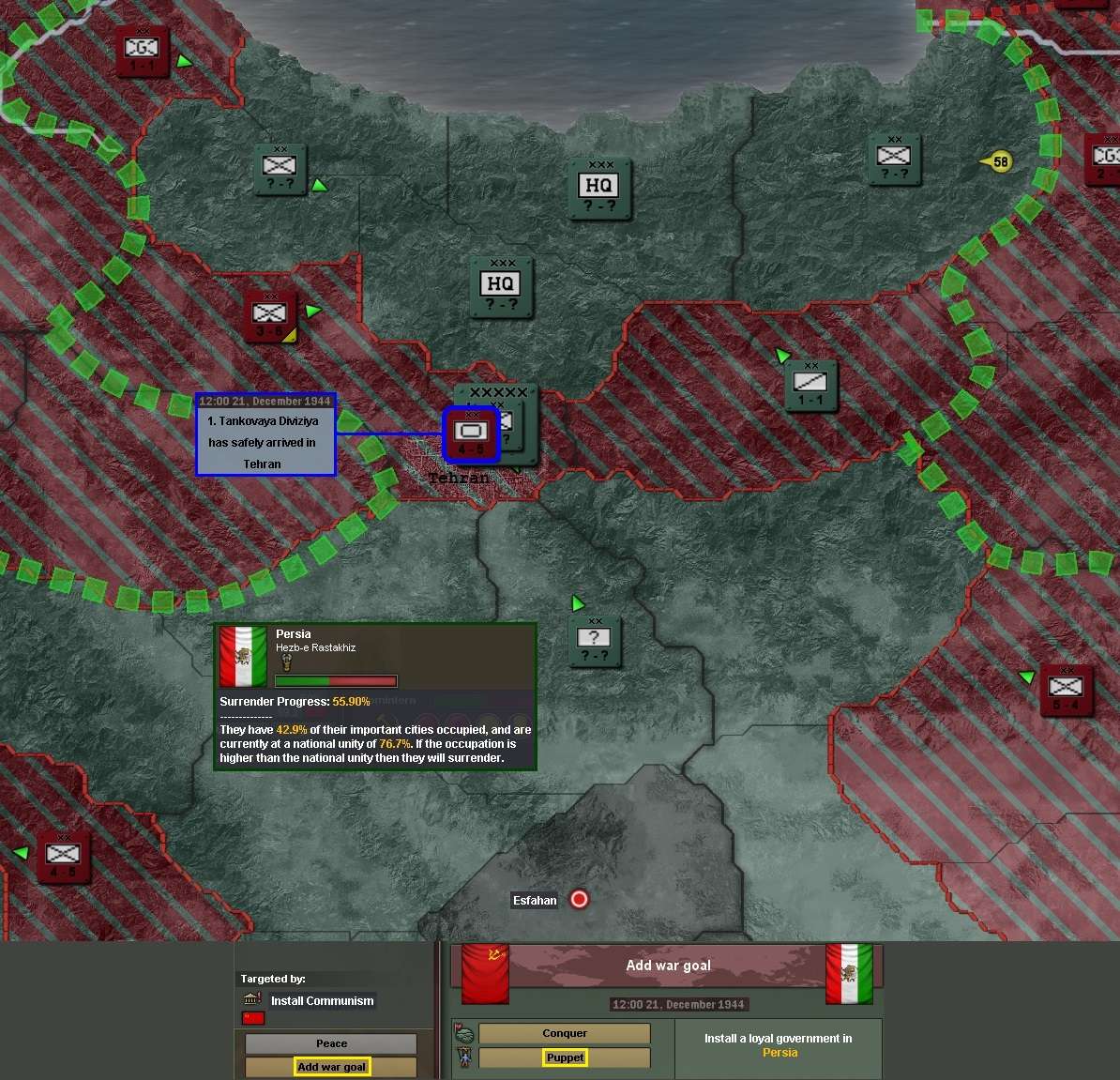
In the east, Borun, which the Persians had reoccupied, was attacked by 325 SD on 14 December and victory celebrated a day later. The Persians would continue to be pushed back in this sector for the rest of the month.
The largest battle of the month in Persia took place in Rasht, on the Caspian coast, from 15 to 21 December. The Soviets overcame dogged Persian resistance to win, with heavy casualties on both sides. A follow-up battle was fought and won there from 29-31 December as the Soviets aimed to destroy the units caught in the pocket. Another large battle was fought and won from 20-24 December in Bandar e Shah, on the east side of the pocket.
The Persians attempted to regain Tehran on 23 December after a failed Soviet attack on Kashan (21-23 December). The determined Persian assault was beaten off with heavy enemy casualties by 29 December. The month finished with a second Soviet attack starting from Tehran against Kashan on 31 December, while in the east, a Soviet attack on Bam had begun on 30 December.
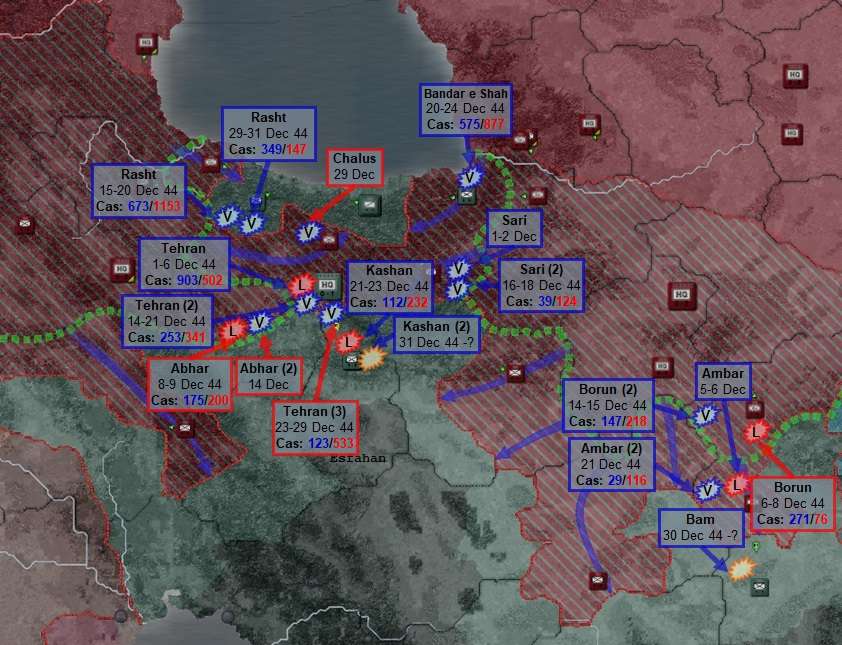
Operational summary, Persia, December 1944.
4. Naval Operations
New transport squadron deliveries will be covered in the production section. Eight more Japanese convoys were sunk by Soviet submarines during the month, with no opposition.
5. Diplomatic and Intelligence
On 21 December, with Japanese counter-espionage resources remaining very low, Soviet counter-espionage there was reduced from high to medium priority [three to two bars] and national unity disruption began [one bar]. But in Manchukuo, a larger enemy threat saw counter-espionage kept at medium priority [two bars] but disruption activity reduced to low priority [two bars to one] on the same day. The loss of another Soviet agent in Manchukuo on 27 December saw all effort [three bars] put into counter-espionage to try to eradicate the local agents. One was indeed neutralised on 30 December.
In Japan, the Kempeitai had started the month with no teams, added another two during the month, with one of them neutralised by the end of it. No Soviet agents were lost there. Manchukuo had started with two agents, then added one and lost one during the month, finishing with what they had started, while eliminating the one Soviet agent mentioned above.
Manchurian national unity was reduced from 69.7% to 69.4% by the end of the month, after efforts were suspended on 27 December. Japan was at 69.2% national unity on 21 December when disruption efforts began there, down to 69.0% by month’s end.
The Soviets had lost the one team overseas, but had trained five more, so finished with a full 10-team presence at home and in Japan and Manchukuo, and now had 14 in reserve, four more than at the end of November. Another one or two and the next target nation would be chosen: if it was to be a major power, a hefty reserve of agents would be needed, just in case of heavy losses. Not trusting the intel screen report for spies captured during the month, these were counted again. The screen reported nine – but a substantial 32 were in fact apprehended from all countries (including Japan and Manchuria) during the month.
The war goals for the main remaining Axis adversaries were reviewed as the month ended. As with Persia, Japan would be made a puppet government after Communism was installed if the Soviets managed to be the ones to dictate the conditions. The French already had similar ideas.
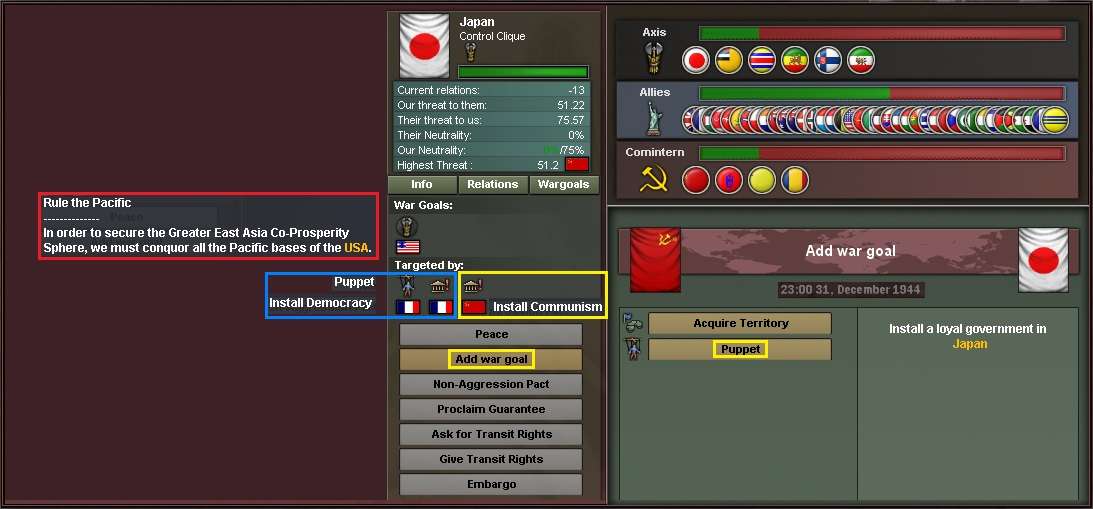
The same would be done for the Japanese puppet states of Manchukuo and Mengukuo.

Soviet diplomatic efforts to recruit Spain, Turkey and Nationalist China into the Comintern were all being neutralised at present by Allied and (in China and Sweden, the latter of which was again trying to self-align) Axis diplomatic initiatives.

******
6. Research
Twin engine airframe designs were upgraded on 8 December. Improved 500kg light bomb technology was the next research to be pursued.

The important breakthrough of drop tanks for single engine aircraft was made on 17 December, but it would take quite some time for the upgrade to be completed for eligible aircraft (those in the Far East had priority) [it has to be 100% complete before the range benefit applies to a wing]. Small fuel tank development was researched next, to further extend range, particularly important in the Far East.

Continuing the light aircraft theme, fighter pilot training was improved on 31 December. Given the very low base it started from, the effort was maintained to take it to the next level.
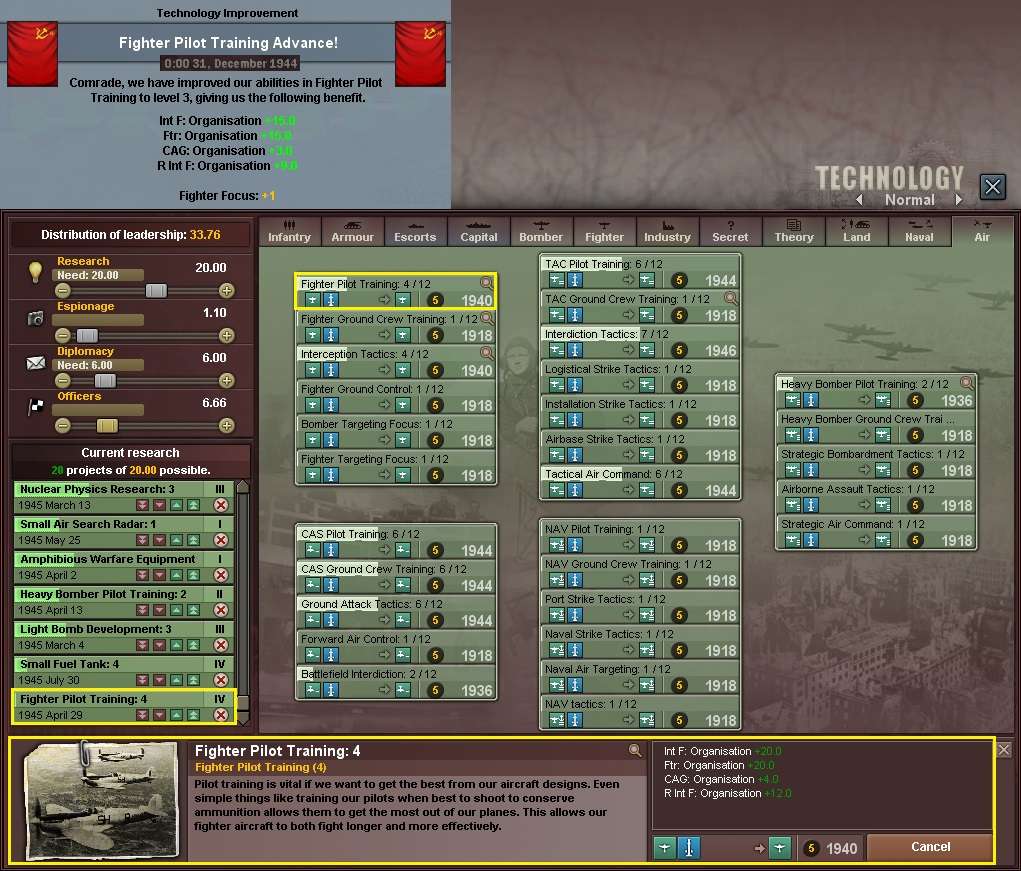
******
7. Production
A new heavy tank division was delivered to 25th Corps in 15th Army on 3 December. Once battle ready, it should provide a fearsome addition to their offensive capabilities. So long as they weren’t employed in the mountains!

Another new transport squadron was delivered to the Red Banner Pacific Fleet on 8 December and two more on 10 December, bringing the capacity to four squadrons in the Far East.
The air base in Mutina – which saw a lot of use in December, with 12 wings based there – was improved to level three facilities on 9 December, with the works rolling on to the next level.
The recent completions saw enough IC freed up to allow two more infantry brigades to be put in training on 10 December and the first Soviet marine brigade to begin training on 11 December. The new infrastructure extension from the Trans-Siberian railway up to Mutina (seven provinces) was also completed on 11 December.
Irkutsk air base was improved to level seven on 16 December and again, expansion continued, with 13 wings based there. And a new mechanised division deployed to Sinyuga, also under 25th Corps command, on 25 December.
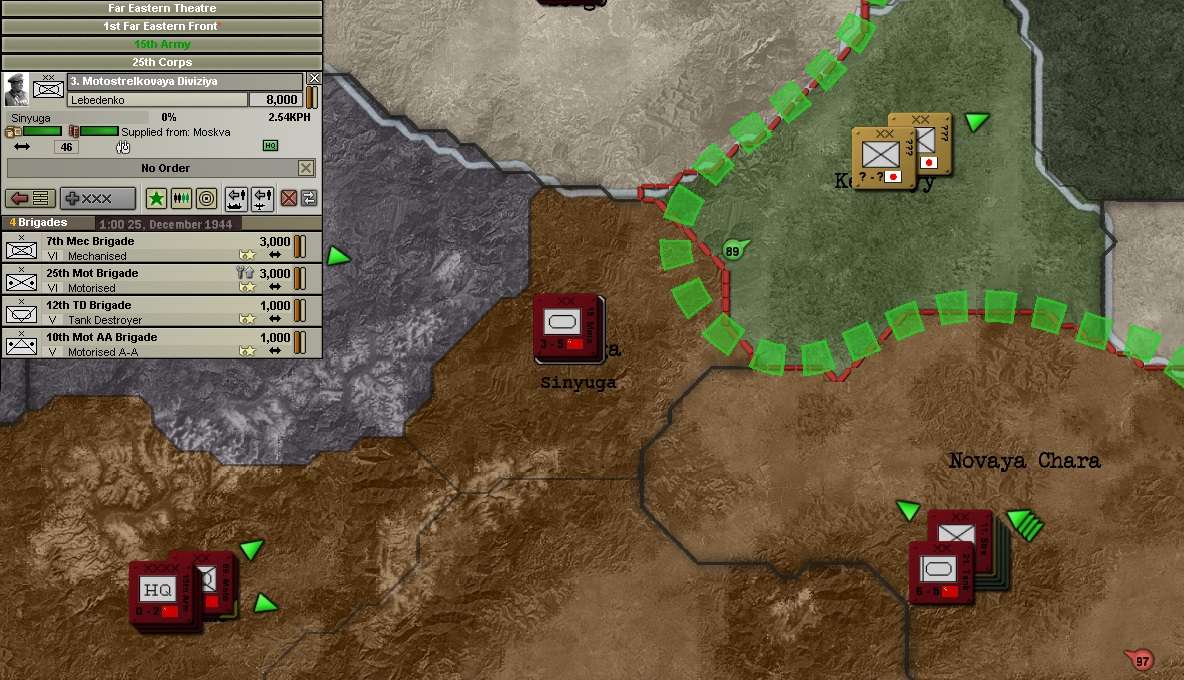
The freed capacity was used to fund construction of two new radar station (probably for use in the west), plus three more marine brigades and an engineer brigade to round out what would become the first Soviet marine division.
Finally, on 30 December the rail extension from Mutina to the Olenek air base in the north (four more provinces) finished construction.
8. Global Summaries
The Far East had seen heavy fighting but little limited exchange of ground: the South saw Ider and then Taryacin regained and held.

Total recorded losses to land combat for battles were far heavier than in November. The Soviets were lost 8,003 men against 10,910 Axis soldiers killed in both theatres. There were only 123 Soviet losses from air raids, with the Axis losing a massive 15,878 to ground attacks, all in the Far East. This brought total Soviet casualties to 8,126 and to 26,788 for the Axis.
South East Asia was largely positive for the Allies in December. They had gained ground in Indo-China, including new landings in the north, near Hanoi.
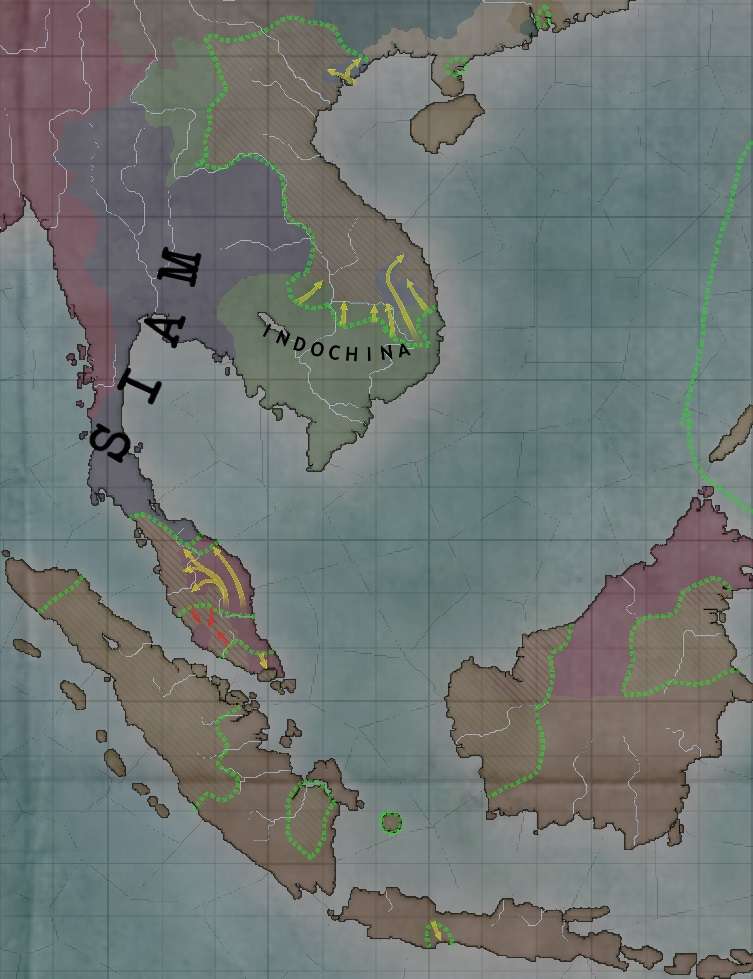
British marines had taken the port of Haiphong, while (perhaps a little curiously given they had already secured a port) the French had almost completed a second landing south-east of Hanoi. It looked intended to outflank the Japanese defence that had been put in place to stop a breakout from Haiphong, but supply could become a problem.

The Allies had regained lost ground and then pushed a salient into Japanese-occupied French Indo-China, forcing the whole Japanese line to fall back.

Ground had been traded in Malaya, Kuala Lumpur and Teluk Anson being lost but the east coast gained by the Allies all the way to the (neutral) Thai border, who had pushed close to Singapore … before seemingly gutting the front of troops before the job was done. Perhaps they had been sent to the Hanoi naval landing?

The Dutch had recovered all of Java but had made only very minor advances in eastern Sumatra. The rest of South East Asia had seen no territorial changes. Nor had the Central Pacific.
In Australia, the Allied offensive in the north continued towards, while the Japanese had also been pushed back again in the south.
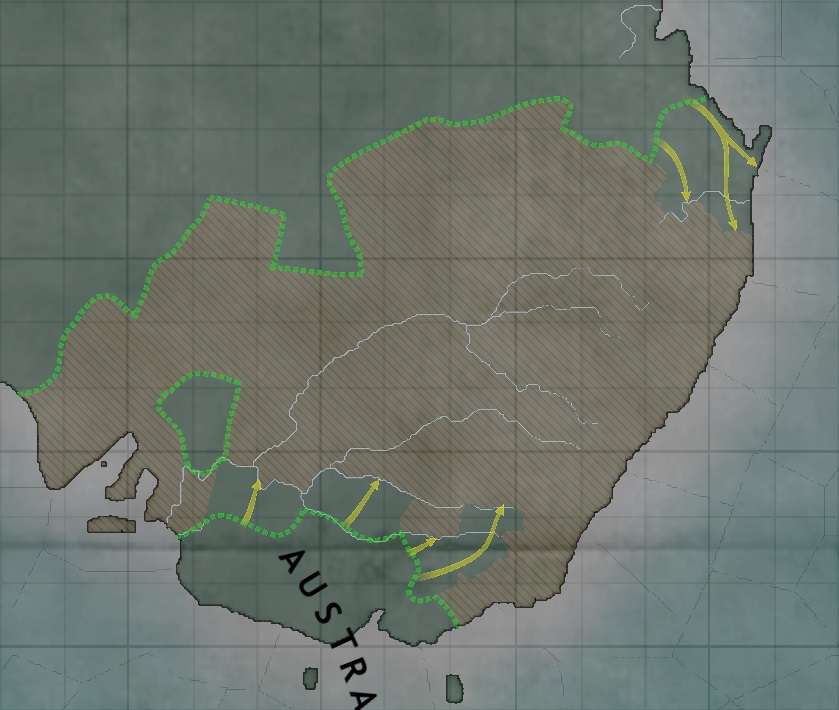
There was as yet no sign of Japanese opposition in Queensland, as the advance approached Brisbane (one wing and one naval unit in Brisbane was all that could be seen).
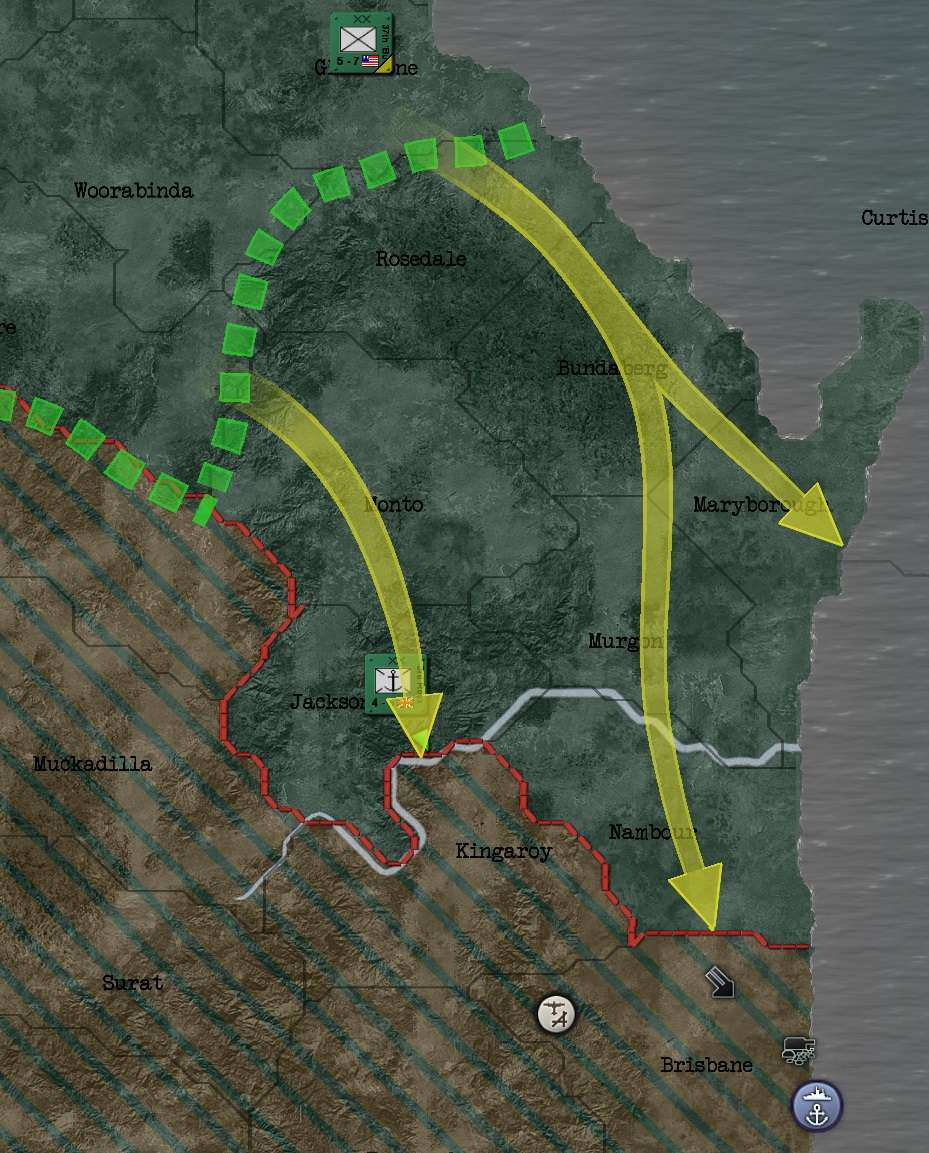
While in Victoria, Australian troops were leading an offensive that had neared the former capital of Canberra, with Japanese forces in retreat from the regional centre of Wagga Wagga, on the Murray River.

AuthAAR’s Notes: With a lot happening in December - in places anyway - I am striving to keep the AAR quick and dirty. I must resist the compulsion to report too much detail! Broad sweep, I keep telling myself. But there was this epic battle, and …
******
Command Adjustments
Before operations kicked off in December, the Soviets adjusted their command structure in the Far East Theatre. 2nd FE Front was brought out of reserve status and assumed command of 1st and 7th Armies in the Southern sector. 1st FE Front retained command of 6th and 15th Armies in the north. The Transcaucasus Front, also pre-positioned in the east, was redesignated as the 3rd FE Front (Reserve) and took command of the two remaining reserve corps HQs. The 2nd FE Front commander, Marshal V.I. Chistyakov, set a mildly aggressive tactical focus for his 206,000 troops.



******
1. Far East Land Combat – Northern and Central Sectors
Combat north of Lake Baikal for December was focused entirely in the Central Sector in and around Novaya Chara, which saw an unprecedented succession of combats over the entire month. The battle there started at 0100 hr on 1 December, with an attack by three Japanese divisions (infantry, guards and marines) on the Soviet 21 Tank Div and 11 SD.
By 0500 on 2 December, the Soviet commander MAJGEN P.A. Mironov had broken up the enemy attack with a counter-attack. The Soviets had the advantage of terrain, a river defence, entrenchment and weather, but were outnumbered about two-to-one.
The Soviets also had air support, with aircraft based in Mutina heavily involved in spoiling attacks on various provinces the enemy were attacking from throughout the month. Their initial focus was on Kedrovvy, then Mogoca, later Erofej Pavlovic. The Japanese launched two air raids (1 x TAC, 1 x MR wing) on Novaya Chara on 2 December, but were intercepted (3 x INT) in two dogfights that day. The Soviets fighter group then aggressively patrolled above the enemy’s air base in Tyndinskiy the next day. The Japanese flyers did not reappear in this sector for the rest of the month.
By 1300 hr on 9 December, the marathon battle in Novaya Chara continued unabated: 11 SD was reaching breaking point, but 21 Tank Div remained strong. The Japanese were also taking heavy casualties [notional progress remained at around 34% in favour of the Soviets, as it had since the start of the battle]. This changed at 2200 hr on 10 December, when 53 Hoheoishidan joined the Japanese attack in reserved [5.9% reinforcement chance, attack progress to 44%].
At 1200 hr on 10 December, 11 SD could take no more: they broke and headed to Sinyuga, leaving Mironov and his 21 Tank Div to withstand the enemy assault from three directions alone.


One reason the Soviet tank division had been able to withstand more than two weeks of Japanese attacks with relatively little organisational damage, when 11 SD had failed, was that the armour of the T-34s of 21 Tank Div [Armour 9] was better than the piercing attack of all the Japanese divisions [maximum of 7]. This heavily reduced the damage they took [ie by 50%].
Finally, at 2100 hr on 15 December, Mironov was advised that two Soviet tank divisions – the 15th (light) from Sinyuga and the 8th (medium) from Dronovskiy – had been ordered to relieve him. But it would take them around ten days to get to Novaya Chara, meaning Mironov and his men had a grim time ahead. At least they had regular (if not continuous) air support on the attacking formations throughout their wait for relief.

But Mironov hung in, and by 0000hr on 21 December, the enemy assault was neutralised with a brave counter-attack and the Japanese marines were now close to breaking. However, the odds had risen [to 77%] in favour of the attackers. Then, at 0600 hr that morning, the news came that the battle was over. The marines had withdrawn and the Japanese broke off their attack! Casualties had been ferocious for both sides, but the Japanese had lost over 3,600 men. Mironov was immediately made a Hero of the Soviet Union for his amazing defensive effort – over twenty days of resistance, much of it with just his own division.

The game names this general P.A. (Andreyevich) Mironov, but I believe he is actually P.V. (Vasilyevich) Mironov. The picture seems to match the latter, as does the rank and service record. They both were impressive and both were made Heroes of the Soviet Union in OTL.
Pavel Andreyevich Mironov (Russian: Павел Андреевич Миронов; 12 December 1919 – 26 April 1945) was a Red Army Junior Lieutenant and a posthumous Hero of the Soviet Union. Mironov was awarded the title Hero of the Soviet Union and the Order of Lenin for actions during the Bratislava-Brno Offensive.
Pavel Vasilyevich Mironov (Russian: Павел Васильевич Миронов; 21 September 1900 – 29 October 1969) was a Red Army lieutenant general and Hero of the Soviet Union. Mironov led the 37th Guards Rifle Corps during World War II.
Pavel Vasilyevich Mironov (Russian: Павел Васильевич Миронов; 21 September 1900 – 29 October 1969) was a Red Army lieutenant general and Hero of the Soviet Union. Mironov led the 37th Guards Rifle Corps during World War II.
Mironov only had four hours to celebrate, however. A new attack [40% starting progress] was launched at 1000 hr that morning, by another Japanese guards division! His exhausted men still had another four days to hold out before relief would arrive. Two hours later, the 12th Hoheishidan joined the reserve and then reinforced at 1400 hr [progress to 77%]. How long could the 21st Tanks, heroes all, hold on?

At 2200 hr on 22 December, as the battle raged on in Novaya Chara, the forces in Sinyuga were diverted from their relief march and instead began an attack on Kedrovvy, to the north of Novaya Chara (neither of the two enemy units there were attacking Novaya Chara at the time). But 8 Tank Div was still advancing from the south-west and was due to arrive on the evening of Christmas Day.
By 1300 hr on 23 December 21 Tank Div held on grimly and Mironov delivery a ‘backhand blow’ [attacker damage -25%, defender damage +25%, attacker speed -30%] to the enemy attack: but the Japanese had brought up yet another fresh division into reserve [attack progress now at 91%]. 20th Hoheishidan reinforced nine hours later. Then at 1500 hr 24 December, Mironov’s masterful delaying tactics were neutralised by a simple enemy assault – his luck and the organisation of his men [now just 3.5] was running out at last.
It proved the decisive blow: able to take no more, 21 Tank Div broke at 0500 hr on Christmas Day 1944, after 24 days of resistance against overwhelming odds. He was awarded an Order of Lenin to complement his recent Hero of the Soviet Union award. [There was no battle report for this one, unfortunately.] 8 Tank Div was due fifteen hours later – so long as the Japanese did not arrive first, Mironov’s withdrawal was actually well timed, allowing the new formation to fight its own battle when it arrived.


Meanwhile, on 27 December, the 6th Army was ordered onto an land attacking stance to see if it could make any progress to the north. And on 30 December, the third battle of the month for Novaya Chara ended in Soviet victory, but again no detailed battle report was available. The province had been under attack for 30 consecutive days but, miraculously, was still firmly in Soviet hands as the year ended.

Operational summary, Soviet Far East – Central Sector, December 1944.
******
2. Far East Land Combat - Southern Sector
The new command arrangements seemed to energise the Southern sector commanders, who soon warmed to their task, in combination with their Mongolian allies. An attack on Ider began at 1000 hr on 1 December, ending in victory early on 4 December, with heavy air support (killing three times as many enemy soldiers from the air than in the land combat). Ider was re-occupied by 81 Mot Div at 1800 hr on 6 December.
Early on 8 December, as a Comintern ground attack on Taryacin was being organised, a Japanese fighter wing made an unwise sortie to intercept inbound Soviet air strikes from Irkutsk. The Japanese themselves were ambushed by Soviet interceptors and were very roughly handled.

Meanwhile, the new 2nd FE Front commander realised he needed to re-send orders for both 1st and 7th Armies to adopt an attacking stance. 1st Army had shown no enthusiasm to do anything with its substantial forces gathered to the north of Lake Baikal. Maybe this would get them moving. It was complemented two days later with a direction for 1st Army’s air units to also go back on the offensive.
But still, nothing happened: Egorov seemed to have lost the will to attack! By 13 December, the need for a diversion to assist the beleaguered 21 Tank Div in Novaya Chara was more urgent than ever. 1st Army was thus ordered to adopt a blitzing stance, in the hope they would drive towards their depth objective of Mildigun.


By now imbued with the spirit of aggression, 7th Army next launched an attack on Dzhirgalanta with 79 SD from Ider, against two weakened Japanese divisions (marines and infantry), at 0500 hr on 21 December. They too received substantial air support from Irkutsk, even while the air strikes continued simultaneously on Tsetserlig. Victory in Dzhirgalanta came on 24 December, but there was no report of casualties available.
26 December rolled around with still no offensive action from 1st Army, which had 11 divisions massed opposite Burjatija and Bukacaca. In a further attempt to promote an attack, those two provinces were made specific objectives, with Mildigun as the depth objective. Marshal Egorov came back with a lame demand for a further 27 medium tank brigades, ten mountain brigades and 45 infantry brigades, even though his own analysts estimated he already outmatched the enemy on his front by a small margin – and heavily (about five-to-one) in the designated attack sector. Soviet authorities were at a loss as to what more they could do to get an attack happening. [And I’m resisting the temptation to step in and take direct command to set up an attack. For now

The attack on Taryacin continued, rather like a smaller parallel of the epic battle in Novaya Chara, with two Japanese infantry divisions and 81 Tank Div both suffering organisational degradation and unrelenting Soviet air attacks on Tsetserlig. By 1100 hr on 30 December one of the Japanese divisions withdrew from the attack and a hard-fought Soviet victory coming at 1500 hr on 31 December. The Japanese had lost over 1,200 men in the ground combat and a massive 6,100-plus in air attacks on Tsetserlig.


Operational summary, Soviet Far East – Southern Sector, December 1944.
******
3. Persia
The Persian Front was highly active in December. The main feature was a drive on Tehran from the west and the east, which eventually led to the cutting off of Persian forces trapped in a large pocket to its north. There was also significant fighting in the east of the country. But especially earlier in the month, the Persians won a number of battles, including attacks on advancing Soviet forces.
By the end of December, the Soviets had the upper hand, keeping the ‘Caspian Sea Pocket’ closed and beating off Persian attempts to retake Tehran, with a separate drive commenced towards the oilfields at the top of the Persian Gulf and a Persian counter-offensive into Borun in the east thrown back.
Of note, a check of Western Front objectives at midnight on 31 November showed they had somehow been erased again from the orders to the subordinate armies, so they were all reinstated (all Persian VP cities).
An initial attack on Tehran began on 1 December but was beaten back by the Persians on 6 December, with heavy Soviet losses. Soon after that, a bold Persian attack on the garrison division holding Borun was launched and would prove successful by 0600 hr on 8 December, after which the Persians in Tehran attacked west against Abhar, defeating 183 SD which had been weakened in its earlier attack on the Persian capital and retreated a day later.
With these initial reverses and a scarcity of armoured units in the theatre, the 6th Cav Corps (currently based near Odessa), consisting of two tank divisions, was transferred to the Western Front’s 23rd Army at 1900 hr on 10 December. Abhar was rescued from enemy seizure when 1 Tank (light) Div reached there at 0900 hr on 14 December, halting the enemy advance after a very quick skirmish. They began their own attack on Tehran four hours later. That would end in a tough victory after a seven day battle, the Persian capital being occupied at 2100 hr on 21 December. This also closed off the ‘Caspian Sea Pocket’ to the north, as 1 Tank Div linked up with Soviet forces that had struck from the east. At this point, the Soviets decided they would if possible puppet Persia after a Communist government had been installed. The Persians moved their capital south to Esfahan.

The largest battle of the month in Persia took place in Rasht, on the Caspian coast, from 15 to 21 December. The Soviets overcame dogged Persian resistance to win, with heavy casualties on both sides. A follow-up battle was fought and won there from 29-31 December as the Soviets aimed to destroy the units caught in the pocket. Another large battle was fought and won from 20-24 December in Bandar e Shah, on the east side of the pocket.
The Persians attempted to regain Tehran on 23 December after a failed Soviet attack on Kashan (21-23 December). The determined Persian assault was beaten off with heavy enemy casualties by 29 December. The month finished with a second Soviet attack starting from Tehran against Kashan on 31 December, while in the east, a Soviet attack on Bam had begun on 30 December.

Operational summary, Persia, December 1944.
******
4. Naval Operations
New transport squadron deliveries will be covered in the production section. Eight more Japanese convoys were sunk by Soviet submarines during the month, with no opposition.
******
5. Diplomatic and Intelligence
On 21 December, with Japanese counter-espionage resources remaining very low, Soviet counter-espionage there was reduced from high to medium priority [three to two bars] and national unity disruption began [one bar]. But in Manchukuo, a larger enemy threat saw counter-espionage kept at medium priority [two bars] but disruption activity reduced to low priority [two bars to one] on the same day. The loss of another Soviet agent in Manchukuo on 27 December saw all effort [three bars] put into counter-espionage to try to eradicate the local agents. One was indeed neutralised on 30 December.
In Japan, the Kempeitai had started the month with no teams, added another two during the month, with one of them neutralised by the end of it. No Soviet agents were lost there. Manchukuo had started with two agents, then added one and lost one during the month, finishing with what they had started, while eliminating the one Soviet agent mentioned above.
Manchurian national unity was reduced from 69.7% to 69.4% by the end of the month, after efforts were suspended on 27 December. Japan was at 69.2% national unity on 21 December when disruption efforts began there, down to 69.0% by month’s end.
The Soviets had lost the one team overseas, but had trained five more, so finished with a full 10-team presence at home and in Japan and Manchukuo, and now had 14 in reserve, four more than at the end of November. Another one or two and the next target nation would be chosen: if it was to be a major power, a hefty reserve of agents would be needed, just in case of heavy losses. Not trusting the intel screen report for spies captured during the month, these were counted again. The screen reported nine – but a substantial 32 were in fact apprehended from all countries (including Japan and Manchuria) during the month.
The war goals for the main remaining Axis adversaries were reviewed as the month ended. As with Persia, Japan would be made a puppet government after Communism was installed if the Soviets managed to be the ones to dictate the conditions. The French already had similar ideas.



******
6. Research
Twin engine airframe designs were upgraded on 8 December. Improved 500kg light bomb technology was the next research to be pursued.



******
7. Production
A new heavy tank division was delivered to 25th Corps in 15th Army on 3 December. Once battle ready, it should provide a fearsome addition to their offensive capabilities. So long as they weren’t employed in the mountains!

The air base in Mutina – which saw a lot of use in December, with 12 wings based there – was improved to level three facilities on 9 December, with the works rolling on to the next level.
The recent completions saw enough IC freed up to allow two more infantry brigades to be put in training on 10 December and the first Soviet marine brigade to begin training on 11 December. The new infrastructure extension from the Trans-Siberian railway up to Mutina (seven provinces) was also completed on 11 December.
Irkutsk air base was improved to level seven on 16 December and again, expansion continued, with 13 wings based there. And a new mechanised division deployed to Sinyuga, also under 25th Corps command, on 25 December.

Finally, on 30 December the rail extension from Mutina to the Olenek air base in the north (four more provinces) finished construction.
******
8. Global Summaries
The Far East had seen heavy fighting but little limited exchange of ground: the South saw Ider and then Taryacin regained and held.

******
South East Asia was largely positive for the Allies in December. They had gained ground in Indo-China, including new landings in the north, near Hanoi.




******
In Australia, the Allied offensive in the north continued towards, while the Japanese had also been pushed back again in the south.



- 1
The AI seems to attack towards the nearest target while keeping the line intact. There is also the option of setting the direction of the attack which seems to limit the frontage to x provinces on both sides of the direction of attack. the width depends on the strength of the attacker.
that makes perfect senseI suspect that a large portion of forum activity is bored folks in the office. Take the bored folk out of the office, and...
he's been really impressive!Mironov’s withdrawal was actually well timed, allowing the new formation to fight its own battle when it arrived.
4 letters: NKVD26 December rolled around with still no offensive action from 1st Army, which had 11 divisions massed opposite Burjatija and Bukacaca. In a further attempt to promote an attack, those two provinces were made specific objectives, with Mildigun as the depth objective. Marshal Egorov came back with a lame demand for a further 27 medium tank brigades, ten mountain brigades and 45 infantry brigades, even though his own analysts estimated he already outmatched the enemy on his front by a small margin – and heavily (about five-to-one) in the designated attack sector. Soviet authorities were at a loss as to what more they could do to get an attack happening. [And I’m resisting the temptation to step in and take direct command to set up an attack. For now.]
AI seems to be intent in doing stupid stuff, but things keep on going good. Even though we didn't take a lot of ground, we caused a lot of casualties. The control of the skies will give us this war, slowly but surely.
This month was great. The uptick in Soviet casualties was matched by an increase in enemy casualties, and there was only territorial gain for the Comintern.
Persia is screwed, with half their army cut off from supplies, they won't last much longer. The only limiting factor now is the terrain and the supply situation.
I don't think that was the smartest place to deploy your new H Arm Division, you're pretty much guaranteeing that the AI will use it in the Mountains.
Malaysia is a bit strange. It looks like the Allies managed to take all the ports, and then shipped out most of their troops for the landings around Hanoi. The Japs then managed to quickly retake Teluk Anson, re-establishing their lifeline before their stockpiles ran out. They had an opportunity to lock down Malaysia for good, and they squandered it. That's actually great news for the USSR, because it means Japan has to keep sending supplies to Malaysia, and will keep losing men there, and the Allies remain too busy with the Japs to even think about attacking the Soviet Union. This blunder has once again delayed the Allied mopping-up of their own colonies.

Persia is screwed, with half their army cut off from supplies, they won't last much longer. The only limiting factor now is the terrain and the supply situation.
I don't think that was the smartest place to deploy your new H Arm Division, you're pretty much guaranteeing that the AI will use it in the Mountains.
Malaysia is a bit strange. It looks like the Allies managed to take all the ports, and then shipped out most of their troops for the landings around Hanoi. The Japs then managed to quickly retake Teluk Anson, re-establishing their lifeline before their stockpiles ran out. They had an opportunity to lock down Malaysia for good, and they squandered it. That's actually great news for the USSR, because it means Japan has to keep sending supplies to Malaysia, and will keep losing men there, and the Allies remain too busy with the Japs to even think about attacking the Soviet Union. This blunder has once again delayed the Allied mopping-up of their own colonies.
I'm taking advantage of the fact that my schedule has cleared right up to work, and hopefully finish, the next update for my AAR, but I guess @nuclearslurpee is right about the majority of readAARs reading and commenting when they get bored on the job. I actually do that when I'm bored at home, or when I'm procrastinating on writing my AAR.In fact I was expecting an uptick in the forums as a result of people staying home instead of catching the virus outside, but it's been the opposite.
I believe the proper solution to this difficulty involves purging, and other elements I'm not supposed to mention on this forum...26 December rolled around with still no offensive action from 1st Army, which had 11 divisions massed opposite Burjatija and Bukacaca. In a further attempt to promote an attack, those two provinces were made specific objectives, with Mildigun as the depth objective. Marshal Egorov came back with a lame demand for a further 27 medium tank brigades, ten mountain brigades and 45 infantry brigades, even though his own analysts estimated he already outmatched the enemy on his front by a small margin – and heavily (about five-to-one) in the designated attack sector. Soviet authorities were at a loss as to what more they could do to get an attack happening. [And I’m resisting the temptation to step in and take direct command to set up an attack. For now.]
The most impressive and shocking thing in this image is that an AI-controlled army actually managed to construct an encirclement.
Gee, I wonder who gave France that idea...The war goals for the main remaining Axis adversaries were reviewed as the month ended. As with Persia, Japan would be made a puppet government after Communism was installed if the Soviets managed to be the ones to dictate the conditions. The French already had similar ideas.
The Far East looks closer to Manchuria than I thought it was, which bodes well for a quick (well...eventual) finish so we can move along to WW3. Will be interesting to see if we can establish a proper Red Banner Indian Ocean Fleet before that starts, post-Iran surrender, to give the Brits a little bit of what-for.
That's interesting - never heard of that capability for setting the direction of an attack, AI or not: had a play just now and couldn't see how it could be done. Is it an HOI3 TFH feature?There is also the option of setting the direction of the attack which seems to limit the frontage to x provinces on both sides of the direction of attack. the width depends on the strength of the attacker.
Mironov is a star (a Red Star)!he's been really impressive!
4 letters: NKVD
AI seems to be intent in doing stupid stuff, but things keep on going good. Even though we didn't take a lot of ground, we caused a lot of casualties. The control of the skies will give us this war, slowly but surely.
I wish sacking and replacing Comd 1st Army (ie NKVD) would be likely to do anything useful, but suspect the next one would be just the same ...
It was a good month, even if not much ground was gained in the Far East. And Persia went very well, even if the enemy did put up a bit of a fight at first (good on them for doing so).
The air force was as impressive in the FE as Mironov!This month was great. The uptick in Soviet casualties was matched by an increase in enemy casualties, and there was only territorial gain for the Comintern.
Persia is screwed, with half their army cut off from supplies, they won't last much longer. The only limiting factor now is the terrain and the supply situation.
I don't think that was the smartest place to deploy your new H Arm Division, you're pretty much guaranteeing that the AI will use it in the Mountains.
Malaysia is a bit strange. It looks like the Allies managed to take all the ports, and then shipped out most of their troops for the landings around Hanoi. The Japs then managed to quickly retake Teluk Anson, re-establishing their lifeline before their stockpiles ran out. They had an opportunity to lock down Malaysia for good, and they squandered it. That's actually great news for the USSR, because it means Japan has to keep sending supplies to Malaysia, and will keep losing men there, and the Allies remain too busy with the Japs to even think about attacking the Soviet Union. This blunder has once again delayed the Allied mopping-up of their own colonies.
I'm taking advantage of the fact that my schedule has cleared right up to work, and hopefully finish, the next update for my AAR, but I guess @nuclearslurpee is right about the majority of readAARs reading and commenting when they get bored on the job. I actually do that when I'm bored at home, or when I'm procrastinating on writing my AAR.
Persia broke open this month, the encirclement being an excellent bonus.
I know re the HArm div, but there's a lot of crappy terrain anyway and I'm hoping they send them north/east once they're worked up. I will see what the AI does
Malaya was a bit whacky, but as you say, that's a problem for the Allies and Japans. Not for Uncle Joe.
Good to hear you have some spare time for your AAR - looking forward to the next update.
I wish a bit of purging to get the desired effect was possible - and for the other solution, well, they're pretty close to the relevant location! Either that, or threaten 1st Army's officer with postings to a punishment battalion!I believe the proper solution to this difficulty involves purging, and other elements I'm not supposed to mention on this forum...
The most impressive and shocking thing in this image is that an AI-controlled army actually managed to construct an encirclement.
Gee, I wonder who gave France that idea...
The Far East looks closer to Manchuria than I thought it was, which bodes well for a quick (well...eventual) finish so we can move along to WW3. Will be interesting to see if we can establish a proper Red Banner Indian Ocean Fleet before that starts, post-Iran surrender, to give the Brits a little bit of what-for.
Yes, a nice big encirclement whilst simultaneously capturing the enemy capital! An early Christmas present from the AI indeed. If only I could transplant the same fighting spirit into 1st Army, who with far fewer troops to hand a while back could not stop attacking the same two provinces!
Hehe, yes, I faintly remember doing that with France's war goals ... about three and a half years ago when I played the first part of this game!
As for finishing off the Japanese so we can get down and dirty in Europe - and indeed across the globe - hell yeah! If I could only get my generals to haul some arse ... still, I probably need the time to get the Soviets up to speed, given they were pretty sickly when the war in Europe ended.
If we'll puppet instead of annex, AI'd better not destroy those pocketed divisions, thoughThe most impressive and shocking thing in this image is that an AI-controlled army actually managed to construct an encirclement.
my thinking is unfortunately not an in-game mechanism but a NKVD political commisar with a Takarov pistol to the general's temple dictating orders to attackI wish sacking and replacing Comd 1st Army (ie NKVD) would be likely to do anything useful, but suspect the next one would be just the same ...
one more thing about general strategy for the future: do you think it makes sense if we didn't even go all-in on NAVs and subs? I mean having them will be nice, but do you think an air-only invasion strategy would work? Like, an EXTENSIVE paratrooper army with a lot of MR fighters would probably do wonders. Still we'd need to carry the armor over sea, but maybe we'll first take out the ports in range first? I mean we're already going on in 4 engine airframes and also on infantry and special ops techs so why not paratroop the hell out of the WW3?
Do you mean setting the 'Axis of Attack' of the HQ? Yes. But I am not so sure how effective it is.
Australia will soon be free! 
Quite a titanic battle in the frozen wastes of Siberia. One must quickly get Sergei Eistenstein to make a stirring film!
Quite a titanic battle in the frozen wastes of Siberia. One must quickly get Sergei Eistenstein to make a stirring film!
But I can’t find anything that lets you do that in vanilla HOI3.Do you mean setting the 'Axis of Attack' of the HQ? Yes. But I am not so sure how effective it is.
Select the AI HQ, shift-right click where you want to go. (had too boot it up to rememberBut I can’t find anything that lets you do that in vanilla HOI3.Any chance of a description of the screen/menu or a screenie of what we’re refeferring to here? I’ve got no idea at all.

Thanks so much!Select the AI HQ, shift-right click where you want to go. (had too boot it up to remember)
But Mironov hung in, and by 0000hr on 21 December, the enemy assault was neutralised with a brave counter-attack and the Japanese marines were now close to breaking. However, the odds had risen [to 77%] in favour of the attackers. Then, at 0600 hr that morning, the news came that the battle was over. The marines had withdrawn and the Japanese broke off their attack! Casualties had been ferocious for both sides, but the Japanese had lost over 3,600 men. Mironov was immediately made a Hero of the Soviet Union for his amazing defensive effort – over twenty days of resistance, much of it with just his own division.
I propose that 21 Tank Div additionally be elevated to Guards status. Mironov may rightfully be celebrated as the architect of this heroic defense, but recognition should also be given to the brave Red Army tankers who resisted with every measure of blood and steel they could give.
26 December rolled around with still no offensive action from 1st Army, which had 11 divisions massed opposite Burjatija and Bukacaca. In a further attempt to promote an attack, those two provinces were made specific objectives, with Mildigun as the depth objective. Marshal Egorov came back with a lame demand for a further 27 medium tank brigades, ten mountain brigades and 45 infantry brigades, even though his own analysts estimated he already outmatched the enemy on his front by a small margin – and heavily (about five-to-one) in the designated attack sector. Soviet authorities were at a loss as to what more they could do to get an attack happening. [And I’m resisting the temptation to step in and take direct command to set up an attack. For now.]
In line with what others are suggesting, might replacing Egorov himself be an option as well? I'm wondering if AI behavior might be affected at least in part by the stats and traits (visible or otherwise) of the formation commanders.
Good ideas both. I will have a closer look at Egorov and see if anything suggests itself. Though a few weeks back he was an energiser attack-bunny!I propose that 21 Tank Div additionally be elevated to Guards status. Mironov may rightfully be celebrated as the architect of this heroic defense, but recognition should also be given to the brave Red Army tankers who resisted with every measure of blood and steel they could give.
In line with what others are suggesting, might replacing Egorov himself be an option as well? I'm wondering if AI behavior might be affected at least in part by the stats and traits (visible or otherwise) of the formation commanders.
so very intuitive UI design of ParadoxSelect the AI HQ, shift-right click where you want to go. (had too boot it up to remember)
Threadmarks
View all 71 threadmarks
Reader mode
Reader mode

